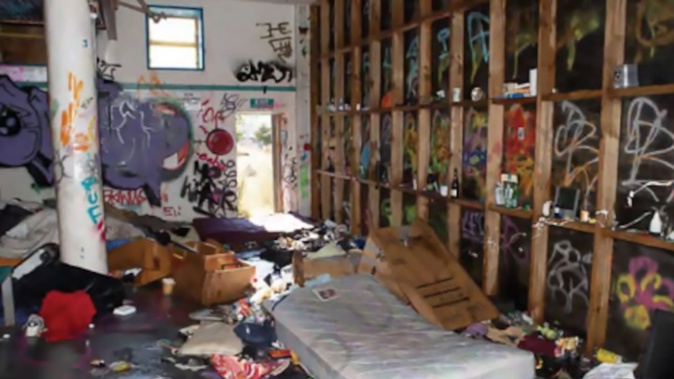
- Firefighters risked their safety to search a burning, abandoned Wellington building earlier this year, fearing squatters could be inside. Nobody was found.
- Forensic photos taken by police following the blaze and released under the Official Information Act now confirm squatters were living inside, and reveal the grim conditions they were living in.
- Groups working to support the city’s homeless population say the images are sad and show just how desperate people are.
The grim reality of homelessness in Wellington has been laid bare in images showing the conditions people were living in inside an abandoned heritage building before it was destroyed by fire.
The former Boys’ Institute building on Tasman St in Mount Cook was gutted by fire in the early hours of April 22. The site also used to house a swimming pool, but that was demolished in 2008 and the main building boarded up.
Firefighters risked their safety to search the interior of the building at the time, despite fears it could collapse, as they were concerned squatters could be inside - but nobody was found.
Initially, authorities treated the blaze as suspicious, but police now say the exact circumstances of the fire are “unable to be determined” and the case is closed.
Photos taken inside the building by a police forensic photographer following the blaze, released to the Herald under the Official Information Act, show squatters were living inside the building prior to the blaze, igniting calls for more to be done to better support those sleeping rough in the capital.
 The former Boys' Institute building on Tasman Street in Wellington after a fire destroyed the property in April 2024. Photo / Police.
The former Boys' Institute building on Tasman Street in Wellington after a fire destroyed the property in April 2024. Photo / Police.
The photos show the walls inside the derelict building covered in graffiti and rubbish and debris strewn across the floors.
Signs of occupancy include clothing on hangers, shoes, a mattress, pizza boxes, bottles of cologne, Winz payment cards, and even a wall clock.
A Nike shoebox sits on a countertop alongside a roll of masking tape and a milk crate.
The issue of squatters inhabiting derelict Wellington buildings made headlines earlier this year after a man fell three storeys through a collapsed stairwell at the boarded-up Pringle House on Wakefield St.
He was not rescued until the following morning, when he was found critically injured.
 Personal items can be seen inside the abandoned building, including clothes on hangers. Photo / NZ Police
Personal items can be seen inside the abandoned building, including clothes on hangers. Photo / NZ Police
Jason Dunn of Prime Property, which owns Pringle House, said at the time there had been a “significant issue” with homeless individuals entering the building.
Dunn said the company had spent in excess of $30,000 to $40,000 to better secure the building this year to try to stop squatters and trespassers from gaining access.
In the aftermath of the Pringle House incident, Wellington City Missioner Murray Edridge said there were hundreds of people sleeping on the streets and in Wellington’s abandoned buildings.
Upon seeing the photos from inside the Boys’ Institute building, Edridge told the Herald it’s a “major indictment on our community”.
“It is just so sad”, he said. “We must make sure that people have somewhere better to live than this.”
“What it says is that people are desperate.
 Bottles of alcohol, cologne, and even a wall clock sit on beams inside the abandoned former Boys' Institute building in Wellington. Photo / NZ Police
Bottles of alcohol, cologne, and even a wall clock sit on beams inside the abandoned former Boys' Institute building in Wellington. Photo / NZ Police
“It won’t just be the ones that are visible. We do see people visibly sleeping rough, we see people visibly sleeping in derelict buildings, but there’s a whole range of other people who are sleeping in caravans and carriages and overcrowded houses, and all of these are part of the homelessness challenge we have as a community.”
Edridge said it’s difficult to quantify the number of people in Wellington experiencing homelessness but said it would be “in the thousands”.
He believes homelessness is increasing in the city, blaming the cost of living, cost of housing, and reduced access to emergency housing.
Edridge said things are “harder now for most people in the community than it’s ever been”.
 A Nike shoebox sits on a countertop inside the abandoned Tasman St building. Photo / NZ Police
A Nike shoebox sits on a countertop inside the abandoned Tasman St building. Photo / NZ Police
Wellington’s Downtown Community Ministry (DCM) is an organisation providing social services to people experiencing homelessness in the capital.
DCM senior leader Natalia Cleland said they had observed a sharp increase in homeless numbers recently, saying the situation was getting worse.
“We are just seeing so many people coming in through the doors, and new people”, she said.
Most recent reporting shows DCM engaged with 264 people experiencing homelessness from July to September, up from 150 people in the prior quarter from April to June - a 76% increase.
The data includes those sleeping on the streets, living in cars, squatting, or in transitional or emergency accommodation.
 Graffiti covers the walls inside. Photo / NZ Police
Graffiti covers the walls inside. Photo / NZ Police
Cleland said it’s tricky to know how widespread squatting is because “it’s so hidden”.
She said the last count of rough sleepers on the streets showed only six people, which doesn’t match the high numbers of homeless individuals using their services.
“We know that they’re homeless but we don’t actually see them on the street. We’re pretty sure that they’re not couch surfing with other people because when we do home visits we’re not seeing them there.
“We’re putting two and two together but we’re making some assumptions that those people are in derelict buildings or in other sort of hidden locations,” she said.
Cleland said they also hear from individuals directly about the derelict buildings they are residing in.
 Rubbish covers the floors in the building. Photo / NZ Police
Rubbish covers the floors in the building. Photo / NZ Police
“We do know that people are squatting, they tell us that.”
But she says it’s not safe or legal for support workers to enter the buildings to help them, and often the issue is only highlighted when things go wrong, such as a fire or people getting injured.
Cleland said there’s also a large number of homeless people living in Wellington’s town belt.
People often assume homelessness is a choice, Cleland said, but she thinks “it’s really more complicated than that” with the vast majority of Wellington’s homeless having a number of complex needs, including criminal history, mental health issues, addiction, and former head injuries.
“It’s pretty tricky, it’s quite complex, but mostly people are coming with several complex factors.”
 Fire damage in the former Boys' Institute building. Photo / NZ Police
Fire damage in the former Boys' Institute building. Photo / NZ Police
The DCM urges members of the public who notice people squatting in derelict buildings to report it to the council, so support services can be dispatched through DCM.
“We really do want to know where those people are so that we can respond,” Cleland said.
The former Boys’ Institute building located at 69-71 Tasman Street in Mount Cook was built more than 100 years ago with the first stone laid in 1914.
It previously housed a boarding home, gymnasium, and a popular pool facility which was the centre of controversy over its demolition in 2008.
The stone building is situated on a hectare of prime land which was cleared by Foodstuffs to make way for a supermarket, but those plans never eventuated and the site is now owned by the Chinese Embassy, which has plans to build a mega-embassy on the site.
Early on the morning of the fire, a representative from the Chinese Embassy attended the scene and spoke to fire crews.
Ethan Manera is a multimedia journalist based in Wellington. He joined NZME in 2023 and is interested in politics, local issues and the public service. Ethan is always on the lookout for a story and can be emailed at [email protected] or messaged on X (formerly Twitter) via the handle @ethanjmanera.
Take your Radio, Podcasts and Music with you









